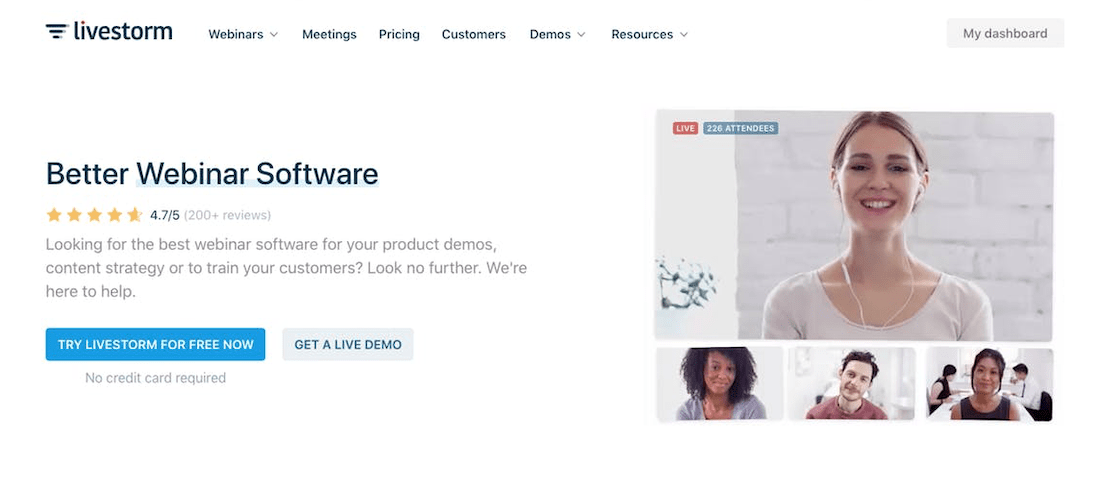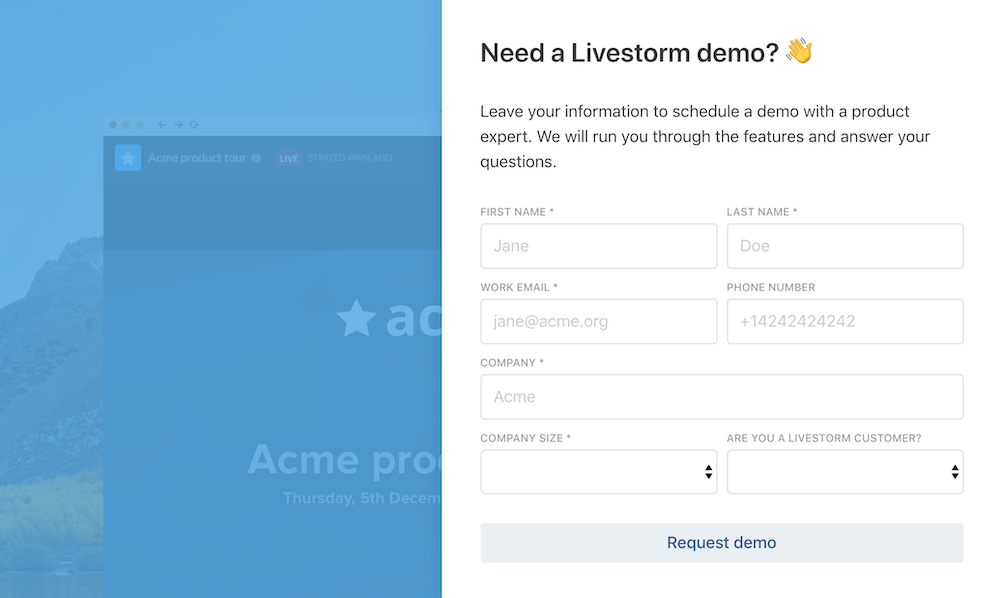Livestorm
See how Livestorm uses Leadfeeder & Prospect.io to identify key site visitors & connect with them—even without form submissions.
In 2016, Livestorm was founded to create the “best webinar software for scaling sales,” and it caught on fast.
In less than two years, the company accumulated more than 200,000 registrants and 5,000+ users. The platform hosts more than 2,000 webinars a month.
The best part: all this growth happened without a single sales person. For those first two years, new customers were most likely contacted personally by the CEO.
Our customers are typically scaling startups, SMBs and mid market companies. Traditionally, we were mostly targeting companies in the software sector but we have an increasing number of customers in the education sector, as well as customers using Livestorm for their own internal events. Thibaut Davoult, Growth Engineer for Livestorm
We only just hired our first salesperson in January [2019] to help with that. So, our DNA is very centered around automation first. This really helped us ask the right questions and finetune our acquisition funnel before hiring our first sales rep, Davoult says.
Livestorm accomplished this lightweight sales strategy by focusing on inbound marketing using stellar content to bring people to the site, then automating the lead generation process (using Leadfeeder and several other tools) to turn site visits into free trials and paid users.
Livestorm is always looking for ways to automate things and find new insights.

We asked Davoult to explain how Leadfeeder fits into their latest and greatest strategy for qualifying leads and moving them through the sales funnel.
Here’s what he told us:
The Goal: Personal Attention to Qualified Leads
Our main goal is to do personalized demos for the most qualified leads that visit our website.
When visitors sign up for a demo, we use a form that helps us sort out qualified and unqualified leads. To do this, we ask questions about company size and whether they are planning to host webinars regularly, etc.). Similarly, we qualify users who sign up for a free trial.
We personally reach out to anyone who matches our ideal customer persona. Everyone else enters a fully automated process where they get a demo from an on-demand webinar or join our weekly live demo webinar.

Leadfeeder helps us identify visitors that are conducting research for a webinar or video software but haven't created an account on Livestorm yet. There's a huge opportunity here to see if they'd be interested in knowing more about Livestorm or to learn why they didn't move forward and create an account.
We use Leadfeeder and Prospect.io to identify the most relevant site visitors and connect to them.
The Process
- We Use Leadfeeder to See Who Has Engaged With Our Site
First, we use the Leadfeeder API to identify companies that have interacted with our website. We use a filter that returns a list of only the most engaged visitors (folks who visit our pricing page, for instance).
- We Download a List of Their Domains and Feed it To Prospect.io
From that list of engaged visitors, we just need a list of their domains written in a format that Prospect.io will understand. To do this we use the following script:
Note: To use the following code snippet, replace SECRET, ACCOUNT_ID, FEED_ID with your variables.
def leadfeeder(next_page)
if next_page != “”
puts "going for next page"
leadfeeder = HTTParty.get(next_page,
:headers => { "Authorization" => "Token token=SECRET" })
else
puts "going for first"
leadfeeder = HTTParty.get("<https://api.leadfeeder.com/accounts/ACCOUNT_ID/leads>",
:query => {
:start_date => Date.today.strftime("%Y-%m-01"),
:end_date => Date.today.strftime("%Y-%m-%d"),
:custom_feed_id => "FEED_ID",
:page[‘size’] => "100",
},
:headers => { "Authorization" => "Token token=SECRET" }
)
end
# Parse response
lfdata = JSON.parse(leadfeeder.body)
# Next page is found
if lfdata['links']['next']
next_page = lfdata['links']['next'].to_s
# Boucle body
lfdata['data'].each do |lead|
if lead[“attributes”]["website_url"]
# Parse domain & Send to Prospect
domain = lead["attributes"]["website_url"].to_s.gsub("<http://www>.", "")
# USE THIRD PARTY SOFTWARE TO ENRICH THE DOMAIN (use is Prospect.io)
puts domain
end
end
else
puts "End of loop"
exit
end
end
After running the script, we save the list of domains as a .csv file and upload that file to Prospect.io using their API.
- We Use Prospect.io to Find the Right Person to Email
We use Prospect.io for our lead and customer outreach, and one reason we like the platform is because it includes a domain-to-email endpoint. It will take a company domain and return any email it finds from people who work there. We take advantage of this feature by feeding Prospect.io’s API our list of domains from Leadfeeder.
- We Add Relevant Emails to a Campaign List
The domain-to-email endpoint also returns a "job title" attribute which we use to filter results and only keep the emails of people in marketing roles. We run this filter and add all of the remaining emails to a Leadfeeder email list we maintain in Prospect.io.
- Last But Not Least: We Reach Out
Once we have a new batch of people, we check the list to see if there’s anyone we want to exclude, and then we manually send out an email campaign out to these new leads.
What’s Coming
This is our current process. However, we know Leadfeeder is capable of helping us qualify our leads even further by filtering visitors by company size and industry. These are very easy ways for us to differentiate qualified and less-qualified leads, and we have plans to update our filter.
Turn Anonymous Website Visits Into Leads Like Livestorm
Leadfeeder’s API gives you a tremendous amount of flexibility to design an automated system for your sales leads. We also offer integrations to hundreds of other cloud services — both native and through our partnership with Zapier.
By feeding Leadfeeder’s data into the other services in-use by your sales and marketing team, you can design a lead follow-up system that’s custom built for the needs of your business.
Share:
View all customer stories →





